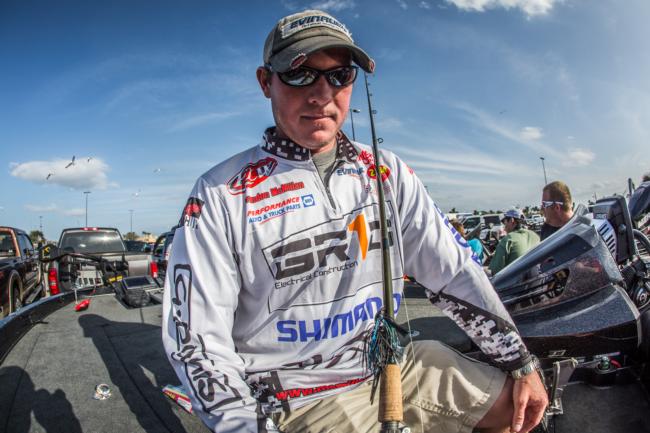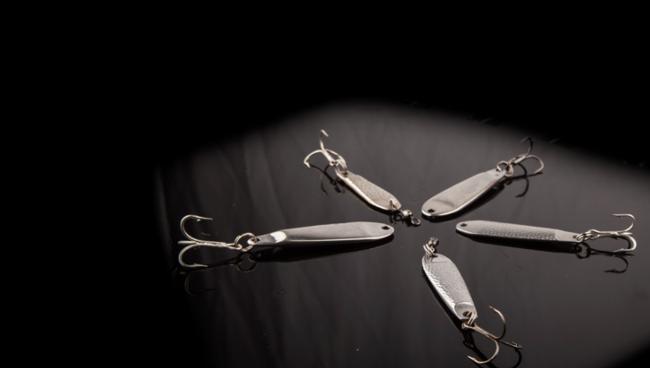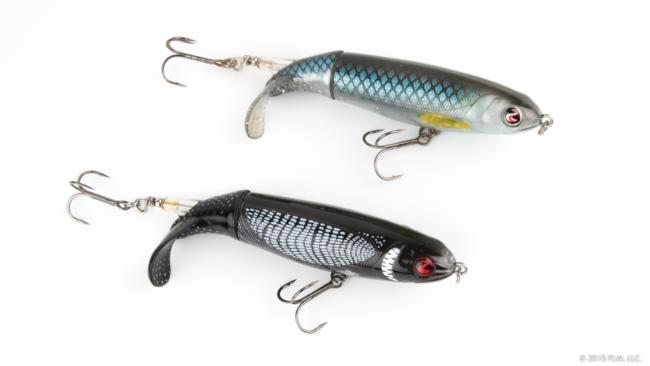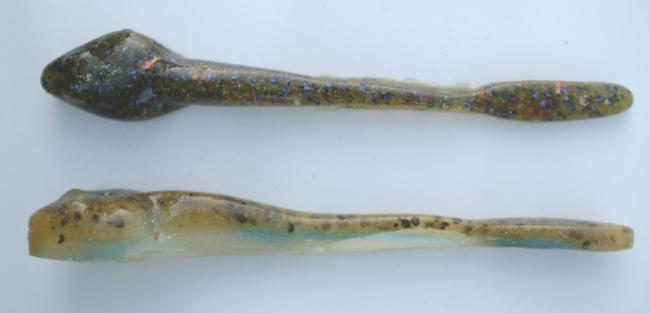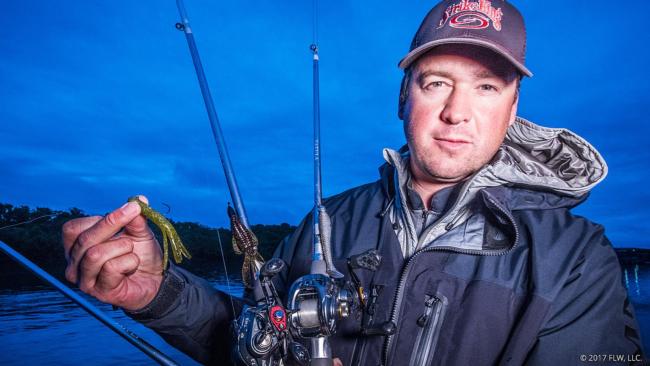5 Proven Late-Season Patterns
Brave the chill and put the finishing touches on the 2017 season with these pro-proven tips

Another year’s on its way out, but there’s still plenty of bass fishing left to do, and several seasonal patterns worth noting. So, amid those shortening days and declining temperatures, consider these late-season opportunities.
1. Follow Florida’s Early Prespawners
Weather-wise, Florida might lack distinct seasonal divisions, but Sunshine State pro Brandon McMillian expects to find fish undertaking well-defined year-end movements. Unheard of anywhere else in the country, largemouths in Florida will be taking up prespawn staging positions while folks are carving turkeys and decorating Christmas trees.
“They like to set up on the outside edges of Kissimmee grass after moving in from their offshore spots,” McMillan says. “They’ll stage here until the first cold front pushes them up shallow, and then they’ll start sliding into the canals or the good spawning flats. So you want to fish the Kissimmee grass outside of the good spawning areas.”
Many Florida lakes sport vast fields of Kissimmee grass, but McMillan narrows his search by targeting boat lanes, which bass use as migration routes to and from spawning grounds. He also watches for noticeably thicker grass amid sparse growth, as well as blended vegetation such as hydrilla growing next to Kissimmee grass or a raft of hyacinth blown into a rooted bed.
“I start with a topwater frog or a buzz toad, and if I can’t get them to come up I’ll use a swim jig,” McMillan says. “I’ll use a 1/2-ounce jig if I need to push deeper into the grass, but in really thick grass I go to 1/4 ounce because it doesn’t bog down. If I need to go deeper, I’ll flip the grass with a 1- to 1 1/2-ounce weight.”
4×4 Brandon McMillan Signature Series Swim Jig with a Zoom UV Speed Craw trailer
Texas-rigged Zoom Z-Craw with 4/0 Mustad Grip-Pin Max Flippin’ Hook and 1 1/2-ounce tungsten weight
2. Jig Spoons Out Deep
Once fall starts yielding to winter’s onset, Anthony Gagliardi knows the deep game holds his best opportunity for quality fish. When he heads offshore, he’s usually armed with a jigging spoon – white for dim conditions, and silver or gold good for sunny days.
“You have to spend time finding them, but you catch a lot of big fish in the late fall on the spoon,” Gagliardi says. “You don’t catch a lot of numbers, but you catch good fish.”
Gagliardi says the spoon bite might start in November, depending on how quickly the cold weather arrives, and he typically begins his search in 25 to 40 feet by graphing creek channels or main-lake flats and looking for shad schools. Other targets include deep humps and brush piles. Depth changes, he says, are less important than finding bait schools.
Sunny, warm afternoons find the shad moving onto the flats, while calm conditions facilitate the boat positioning and vertical deployment necessary for targeting fish with the spoon. Wind tends to push around the bait, and with the bait goes the fish, while a light breeze allows Gagliardi to dial in.
“It’s not an easy way to catch them. It’s not like there’s a bunch of fish everywhere, but it’s a great way to catch a really big bag,” Gagliardi says. “That time of year, your only way to catch a big fish is out there in that open water.”
1/2- to 1-ounce hammered Hopkins Spoon
1/2- to 1-ounce hammered Cotton Cordell Spoon
3. Plop Shoreline Rock on Top
Fall drawdowns might limit some patterns on reservoirs, but for Missouri pro James Watson, the annual water-level reductions bring big-time opportunities that more than offset any losses. Topwater fishing is his favorite way to capitalize on a pattern rooted in seasonal forage abundance.
“What makes this so productive is the presence of bluegills and gizzard shad and the fact that the fish get shallow and very predictable,” Watson says. “When they’re there, it’s a pattern you can run throughout the entire lake.”
On highland reservoirs such as Table Rock, Norris Lake and Fort Loudoun-Tellico, Watson targets rocky flats, points or brush piles in pockets in the shallowest water. By running the bank and scanning visually, his approach doesn’t require electronics. Yet, it’s a simple way to pattern fish based on their preferred bottom content and location relative to the main lake. Basically, try various areas relative to the main lake, and then hit similar areas once you get a few bites.
“I can drive down the lake and look and see the targets that could be holding bass,” he says. “I can base that on whether they’re on the main lake; if they’re inside the creeks, coves and cuts; or if they’re in the backs of creeks, coves and cuts. That’s a pattern that gets better as fall progresses and the water cools off.”
Watson prefers topwater presentations for covering water and generating memorable strikes. His rule of thumb: Fish a subtler buzz toad for calm days and noisier baits like a River2Sea Whopper Plopper or a spinnerbait waked up top for the windier days.
white, black or translucent River2Sea Whopper Plopper
buzz toad on a 5/0 EWG hook with a screw-lock keeper
4. Pinpoint Deep-Water Northern Smallies
Matt Stefan, the seventh-year pro from Junction City, Wis., calls late fall his favorite time to fish, and regular five-bass catches of 25-plus pounds substantiate the claim. Fishing inland lakes throughout northern Wisconsin and neighboring Minnesota, Stefan targets smallmouths on deep rocky bars and the ends of rocky points.
The ideal scenario is a bar or point with a flat spot that evens out before tapering into deep water. Fish set up on that flat spot, which becomes a “gathering area,” and spots as deep at 50 feet are in play, with water clarity the main determinant – the clearer the water, the deeper the fish stage. According to Stefan, the bite improves as hard-water season gets closer.
“You’ll have fish transitioning to these areas in October, but as it gets later you’ll have more fish moving to these areas,” he says. “Once they get there, they’re going to stay all the way until ice-out. So, the later in the season it gets, the better it is because the fish start grouping up even tighter.
“You don’t catch many small ones. The fish have been feeding all fall for the winter period, so they’re at the heaviest weight. I feel like the biggest fish in the lake are more easily accessible because they’re all grouped up together.”
With the fish typically hugging the bottom, Stefan peppers a likely area with swimbaits until he finally stimulates the generally lethargic fish. One bite often triggers a rally, which he’ll exploit with a rotation that includes a drop-shot, tube and finesse jig.
various swimabits on 1/2- to 3/4-ounce Dirty Jigs Swimbait Heads
Poor Boys Baits Goby on a drop-shot
Poor Boys Baits Darter on a drop-shot
4-inch Yamamoto Senko on a drop-shot
Strike King Bitsy Tube with a 3/8-ounce jighead
3/8- to 1/2-ounce Dirty Jigs Luke Clausen Compact Jig with a Strike King Menace Grub trailer
5. Drag Deep Points out West
California pro Cody Meyer says late fall finds Western bass transitioning from their baitfish diets to a crawfish preference. This often moves the fish out to the main lake where they’ll cluster around long clay points with scattered rock where the fish can move up and down to adjust with sunlight and activity periods.
“The bite can be really good this time of year,” Meyer says. “The fish are fattening up for winter, so they’re definitely feeding.”
Early morning and afternoon seem to be the most productive times in Meyer’s experience, and overcast skies and light winds will often make the fish respond more aggressively. A typical late-fall day finds a midday lull shattered by an aggressive sundown rally.
Running enough points usually yields fish, but Meyer searches efficiently by casting a 1/2- to 3/4-ounce football-head jig across the points and trying different angles to see if one direction outperforms the rest. He’ll use a 3 1/2-inch tube as his cleanup bait, but he foregoes the more common spinning outfit in favor of the same 7-foot, 3-inch, medium-heavy baitcasting rod he uses with the football head.
“Typically, I’m dragging a tube, and the baitcasting gear gives me a little more control,” Meyer says. “The fish typically aren’t line-shy that time of year, so the spinning gear isn’t needed. And when you hook one on baitcasting gear, you’re not going to lose him.”
3 1/2-inch Strike King Coffee Tube in a natural crawfish color on a 1/4- or 3/8-ounce tube head
1/2- to 3/4-ounce Strike King Tour Grade Football Jig with a Strike King Rage Chunk trailer
